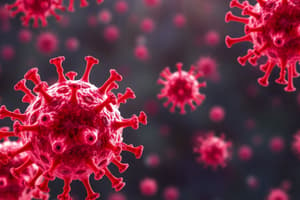Podcast
Questions and Answers
Which hormone is secreted by the parathyroid gland and increases blood calcium levels?
Which hormone is secreted by the parathyroid gland and increases blood calcium levels?
- Estrogen
- Parathyroid hormone (correct)
- Luteinizing hormone
- Calcitonin
What is the main target tissue of calcitonin?
What is the main target tissue of calcitonin?
- Kidneys
- Thyroid
- Bone (correct)
- Liver
What is the role of luteinizing hormone (LH) in women?
What is the role of luteinizing hormone (LH) in women?
- Stimulates bone formation
- Causes the release of progesterone and estrogen (correct)
- Inhibits osteoclastic bone reabsorption
- Increases blood calcium levels
Which type of immunity is characterized by antibodies found in the blood plasma?
Which type of immunity is characterized by antibodies found in the blood plasma?
Which type of T cell directly attacks infected cells?
Which type of T cell directly attacks infected cells?
Where are the axillary lymph nodes located?
Where are the axillary lymph nodes located?
What is the main function of lymph nodes?
What is the main function of lymph nodes?
Which type of white blood cell is responsible for phagocytosis?
Which type of white blood cell is responsible for phagocytosis?
What is the function of thrombocytes in the blood clotting process?
What is the function of thrombocytes in the blood clotting process?
What is the main function of albumin in the blood?
What is the main function of albumin in the blood?
What is the process of red blood cell formation called?
What is the process of red blood cell formation called?
Which of the following is NOT a factor that can trigger the release of norepinephrine from the adrenal medulla?
Which of the following is NOT a factor that can trigger the release of norepinephrine from the adrenal medulla?
Which wave in an ECG represents the depolarization of the ventricles?
Which wave in an ECG represents the depolarization of the ventricles?
Which layer of blood vessels is composed of endothelial tissue, collagen fibers, elastic fibers, and smooth muscle tissue?
Which layer of blood vessels is composed of endothelial tissue, collagen fibers, elastic fibers, and smooth muscle tissue?
Which of the following is the purpose of the hepatic portal vein?
Which of the following is the purpose of the hepatic portal vein?
Which hormone is responsible for regulating the production of a large volume of urine and increasing blood pressure?
Which hormone is responsible for regulating the production of a large volume of urine and increasing blood pressure?
Which gland is responsible for the release of epinephrine and norepinephrine?
Which gland is responsible for the release of epinephrine and norepinephrine?
Which hormone is responsible for accelerating the rate of glucose synthesis and glycogen formation, and has anti-inflammatory effects?
Which hormone is responsible for accelerating the rate of glucose synthesis and glycogen formation, and has anti-inflammatory effects?
Which gland is responsible for producing melatonin, which is responsible for circadian rhythm and initiating sleepiness?
Which gland is responsible for producing melatonin, which is responsible for circadian rhythm and initiating sleepiness?
Which of the following is true about the cardiac cycle?
Which of the following is true about the cardiac cycle?
What happens during the Isovolumetric Ventricular Contraction phase of the cardiac cycle?
What happens during the Isovolumetric Ventricular Contraction phase of the cardiac cycle?
What happens during the Isovolumetric Ventricular Relaxation phase of the cardiac cycle?
What happens during the Isovolumetric Ventricular Relaxation phase of the cardiac cycle?
What is the equation for cardiac output?
What is the equation for cardiac output?
Study Notes
Hormones and Glands
- Parathyroid hormone, secreted by the parathyroid gland, increases blood calcium levels.
- Calcitonin, produced by the thyroid gland, targets bone cells to reduce blood calcium levels.
- Luteinizing hormone (LH) in women stimulates ovulation and corpus luteum formation.
Immunity and Blood
- Humoral immunity is characterized by antibodies found in blood plasma.
- Cytotoxic T cells directly attack infected cells.
- Axillary lymph nodes are located in the armpits.
Blood Components and Functions
- Lymph nodes filter the lymph and trap pathogens and foreign substances.
- Neutrophils, a type of white blood cell, are responsible for phagocytosis.
- Thrombocytes (platelets) play a crucial role in the blood clotting process.
- Albumin, a protein in the blood, maintains osmotic pressure and transports molecules.
Blood Formation and Circulation
- Erythropoiesis is the process of red blood cell formation.
- The hepatic portal vein carries nutrient-rich blood from the digestive organs to the liver.
Nervous and Endocrine Systems
- Norepinephrine is released from the adrenal medulla in response to stress, but not in response to laughing.
- The QRS complex in an ECG represents the depolarization of the ventricles.
- The tunica intima, a layer of blood vessels, is composed of endothelial tissue, collagen fibers, elastic fibers, and smooth muscle tissue.
Hormones and Their Roles
- Aldosterone regulates the production of a large volume of urine and increases blood pressure.
- The adrenal medulla releases epinephrine and norepinephrine.
- Cortisol accelerates the rate of glucose synthesis and glycogen formation, and has anti-inflammatory effects.
- The pineal gland produces melatonin, regulating circadian rhythm and inducing sleepiness.
Cardiac Cycle
- The cardiac cycle involves a series of events that generate a heartbeat.
- During the Isovolumetric Ventricular Contraction phase, the ventricles contract without a change in volume.
- During the Isovolumetric Ventricular Relaxation phase, the ventricles relax without a change in volume.
- The equation for cardiac output is CO = HR x SV, where CO is cardiac output, HR is heart rate, and SV is stroke volume.
Studying That Suits You
Use AI to generate personalized quizzes and flashcards to suit your learning preferences.
Description
Test your knowledge on the phases of the cardiac cycle and their importance in measuring blood flow, pressure changes, and volume. This quiz will cover the five steps involved in this crucial cardiovascular process.




